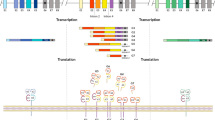Abstract
The extreme polymorphism of the histo-compatibility antigens may have evolved to ensure that the body of an individual is not invaded by cells from another individual of the same species.
Similar content being viewed by others
References
Amos, D. B., et al., Fedn Proc., 31, 1087 (1972).
Jerne, N. K., Eur. J. Immunol., 1, 1 (1971).
Burnet, F. M., Cellular Immunology (Cambridge University and Melbourne University Presses, 1969).
Burnet, F. M., Br. med. Bull., 20, 154 (1964).
Burnet, F. M., Acta path. microbiol. scand., 76, 1 (1969).
Bodmer, W. F., Nature, 237, 139 (1972).
Burnet, F. M., Nature, 232, 230 (1971).
Author information
Authors and Affiliations
Rights and permissions
About this article
Cite this article
BURNET, F. Multiple Polymorphism in Relation to Histocompatibility Antigens. Nature 245, 359–361 (1973). https://doi.org/10.1038/245359a0
Issue Date:
DOI: https://doi.org/10.1038/245359a0
- Springer Nature Limited
This article is cited by
-
Anti-Idiotypic autoimmunity - a necessity for species survival
Survey of Immunologic Research (1984)
-
Analysis of two genetic models for the innate components of colony odor in social Hymenoptera
Behavioral Ecology and Sociobiology (1979)





